We Can Mitigate LA’s Fire Danger – from the Comfort of Our Gardens!
FormLA Staff: Who hasn’t, at some point, wanted to be a fire fighter? Well, we have good news! Smokey the Bear wasn’t kidding – we all play a part in preventing forest fires!
One of the most strategic things we can do is plant right. That means avoiding invasive plants that travel from our gardens into open space, where they become highly combustible fuel. Easy breezy, right? The problem is, some of the naughtiest plants have been promoted as solutions to drought!
Let us introduce you to the naughtiest of the naughty plants, LA’s ace arsonists: Fountain, Pampas and Feather Grass. Once you recognize them, you’ll see just how much power we have to mitigate our fire danger.
Fountain Grass
The Problem: Fountain Grass quickly leaves our gardens and will fill virtually any open space it can find. We see it in the cracks of sidewalks, abandoned medians – we’ve even had to pull it from the middle of well-established Brittlebush! When it reaches wild space, its fine, flashy, dry leaves provide ample fuel for fire.

A Solution: Roger Klemm understood the Fountain Grass featured above, adjacent to the Sunland entrance to the 210, posed a danger to the community. He advocated for and organized removal of Fountain Grass. The garden is now a lush, leafy, green, fire-wise example that brings the community together. He has created a beautiful example for the community to follow: See the Garden Now
Caution: PlantRight, a resource for identifying invasive plants and promoting non-invasive alternatives, cautions: “Green fountain grass seeds prodigiously, and the seeds remain viable in the soil for at least seven years. The seeds can disperse by wind, water, and possibly birds. If removing this plant when in flower, carefully cut off seed heads and place them in a bag to avoid spreading the seeds.”
Pampas Grass
The Problem: Pampas Grass can be seen in Ballona Wetlands and lining slopes adjacent to PCH. Like so many of our naughty plants, it is so ubiquitous in our wild spaces, it is often mistaken for native.

Like Fountain Grass, Pampas Grass becomes a fire hazard when it enters our wild spaces. As its size is significant, so is its hazard. Plant Right notes why even one plant is a problem: “A single pampas grass plume can produce 100,000 seeds annually, and the seeds can blow up to 20 miles in the wind. This allows the grass to spread rapidly and colonize new areas.”
Solutions: Of course, simply not planting Pampas Grass helps, as does its removal from gardens and open spaces. There are additional steps you can take. Plant Right notes that Pampas Grass “quickly colonizes bare ground but does not establish as well when its seedlings have to compete with native grasses or sedges. So…IdealMow lawn anyone? No garden? No problem! The California Coastal Commission has also organized volunteer groups to remove Pampas Grass from sensitive areas.
Feather Grass
The Problem: We are all familiar with the golden waves of Feather Grass, planted en-mass in response to drought. Once you recognize it, you will start seeing it everywhere! It takes every opportunity to reseed itself, and this time of year, you are likely to see it, brown and dry in medians, on the sides of roads and in the cracks of sidewalks.
Plant Right describes the danger it presents: “It forms dense stands that thrive in dry areas, increasing the fire hazard. Fire simply enhances seeding and does not get rid of the plant.”

A Solution: Help Plant Right and Cal-IPC track the spread of Feather Grass via Calflora. As with other arson grasses, look for opportunities to remove grass where possible, and encourage friends and neighbors to plant native alternatives like Aristada.
How to Help
There are clear steps we can all take to increase LA’s fire safety. We can:
- Learn to identify arson grasses
- Remove arson grasses from our home gardens
- Join or organize community groups to remove Pampas, Fountain, and Feather Grass from public spaces
- Plant nativefire wise plants in home and community gardens
- Alert Calflora when we see arson grasses
- Buy native to encourage nurseries to carry more native and fewer invasive plants
- Advocate for state funding to remove these grasses from wild space
Learn More
Quiz: Are you a fire fighter?
PlantRight: Avoid Fountain Grass
PlantRight: Avoid Pampas Grass
Plant Right: Avoid Feather Grass
KTLA: 3 Fire-Safety Myths That Endanger LA
California Invasive Plant Council
LA Times: 7 Fire Wise Plants
FormLA: Feather Grass vs. Aristada
FormLA: Pampas Grass vs. Yucca Whipplei
Sunland Welcome Nature Garden: Fountain Grass vs. Deer Grass
Sunland Welcome Nature Garden: The Arsonists
Authentic Foothill Gardens: The Fire Garden
Pinterest: Fire Wise Plant Palette
Calflora Database
PlantRight Education Programs
Theodore Payne Foundation Education Programs